Geological Terms Beginning With "M"
For terms beginning with other letters, please click below
|

Maar
A maar is a small, shallow volcanic crater with steep sides that forms in an explosive volcanic eruption that is triggered when rapidly ascending magma contacts groundwater at a shallow depth and a steam explosion occurs. Maars are usually surrounded by tephra deposits that are thickest near the maar and thin with distance. Most maars are only a few hundred to several thousand feet across and are at most a few hundred feet deep. After cinder cones, they are the second most common volcanic landform.

Mafic
A term used to describe an igneous rock that has a large percentage of dark-colored minerals such as amphibole, pyroxene, and olivine. Also used in reference to the magmas from which these rocks crystallize. Mafic rocks are generally rich in magnesium and iron (think MAgnesium and FerrIC). Basalt and gabbro are examples of mafic rocks. (See felsic to contrast.)

Magma
Molten rock material that occurs below Earth's surface. When it erupts onto the surface, it is known as "lava."

Magma Chamber
A subsurface reservoir of magma at a shallow depth in Earth's crust. It can serve as a source of magma and gases for volcanic eruptions if it connects to the surface through a pipe or connects to another magma chamber through a dike or a sill. Some magma chambers never produce a volcano and slowly cool to produce a differentiated mass of igneous rock.
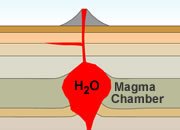
Magmatic Water
Water that is dissolved in a magma or water that is released from a magma. Some magmas can contain up to several percent dissolved water by weight. The presence of water can lower the melting temperature of a rock.
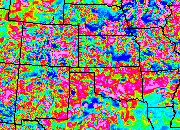
Magnetic Anomaly
An increase or decrease in the local magnetic field compared to the normally expected value. The image is a section of the United States Geological Survey's full spectrum magnetic anomaly grid of the United States with improved long wavelengths for studying continental dynamics.

Magnetic Declination
The horizontal angular difference between Geographic North and Magnetic North. This angular difference varies, depending upon your location on the face of the Earth.

Magnetic Inclination
The vertical angular difference between a horizontal plane and the orientation of Earth's magnetic field. Near the magnetic equator the magnetic inclination will be approximately zero. As the pole is approached the magnetic inclination will increase, and at the magnetic pole the magnetic inclination will be 90 degrees.

Magnetic North
The direction that a compass points. The location where Earth's magnetic field dips vertically into the Earth.
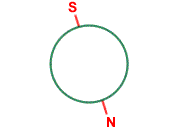
Magnetic Reversal
A change in the polarity of Earth's magnetic field in which the north magnetic pole becomes the south magnetic pole and vice versa. Also known as geomagnetic reversal or polarity reversal. Earth's magnetic field has reversed many times in the past, and the time intervals between these changes are known as polarity epochs.

Magnetic Stratigraphy
The correlation of rock units and the study of Earth's history using magnetic events and magnetic epochs as a time reference.

Magnetometer
An instrument designed to measure the strength and character of Earth's magnetic field or the magnetic properties of the underlying rocks. There are many types of magnetometers for different scales of measurement and for different methods of surveying. Some are carried by hand or in vehicles. Others are towed behind ships or aircraft.

Magnitude
A measure of earthquake strength based upon the amount of ground motion experienced and corrected for the distance between the observation point and the epicenter. There are several magnitude scales in use.

Malachite
Malachite is a copper carbonate mineral that has served as a minor ore of copper. It has a bright green color, often with beautiful banding, swirl, and eye patterns. This makes it an attractive gemstone. Because it is soft and cleaves easily, malachite is best used in items that will not be subjected to abrasion or impact.
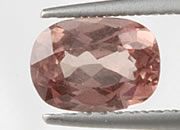
Malaya Garnet
Malaya is a pink to pinkish brown or reddish variety of garnet. Compositionally, it is a mixture of pyrope, almandine, and spessartine. It is occasionally seen in jewelry.

Mali Garnet
Mali is a yellow to yellowish green variety of garnet, named after the African country of Mali. It is a mixture of grossular and andradite that is occasionally seen in jewelry. It has great dispersion (fire) as seen in this photo.

Manganese nodule
A rounded concretion, rich in manganese minerals with minor concentrations of cobalt, copper, nickel, and other metals. These nodules are abundant on some parts of the deep ocean floor and have been considered as a potential source of manganese. The photo shows iron-manganese nodules on the seafloor north of the Puerto Rico Trench at a depth of about 5339 meters. The nodules are about two to four centimeters in diameter.

Mantle
A major subdivision of Earth's internal structure. Located between the base of the crust and the top of the core. It is approximately 1800 miles thick and has a composition that is distinctly different from the crust above and the metallic core below. The mantle makes up about 84% of Earth's volume.

Mantle Plume
A rising mass of hot mantle material that can create an area of volcanic activity in the center of a lithospheric plate. The illustration shown here is a simplified representation of the mantle plume that produced the Hawaiian Islands.

Marble
A non-foliated metamorphic rock that is produced from the metamorphism of limestone. It is composed primarily of calcium carbonate. It is often used as a building stone in prestige architecture. The photo shows part of the West Building of the National Gallery of Art, which has extensive use of marble in both the exterior and interior.

Mariposite
“Mariposite” is an informal name that is most often used for green micas that are thought to be colored by small amounts of chromium. The “mariposite” name has also been used for a group of green and white metamorphic rocks that contain significant amounts of green mica. During the California Gold Rush mariposite was the source of much placer gold and was also mined as an ore. Because of this mariposite became an indicator of potential gold and served as a tool for gold prospecting.

Mary Ellen Jasper
Mary Ellen is a rock that consists of red jasper and hematite with a submetallic luster. The jasper is a fossil stromatolite, a layered structure built up by sediment-trapping algae that lived on Earth about two billion years ago - long before land plants.
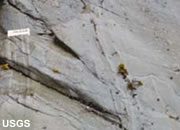
Massive
A term used in reference to a rock unit that is homogeneous in texture, fabric, and appearance.

Mass Wasting (also Mass Movement)
A general term used for any downslope movement of rock, soil, snow, or ice under the influence of gravity. Includes: landslides, creep, rock falls, and avalanches.

Matrix Opal
Matrix opal is a material in which precious opal is in an intimate mixture with the host rock, instead of being confined to seams and patches. The specimen in the photo is from Andamooka, Australia, and is a sedimentary rock with opal filling the voids between sedimentary grains.
Maw Sit Sit
Maw sit sit is a rock composed of jadeite, albite, and kosmochlor (a mineral related to jadeite). It is attractive, has a bright chrome green color and accepts a bright polish, and for those reasons it is used as a gemstone.

Mcf
One thousand cubic feet - a standard production and sales volume for natural gas. (The "M" represents the Roman numeral for one thousand.)

MMcf
One million cubic feet - a standard production and sales volume for natural gas. (The "M" represents the Roman numeral for one thousand. Two "M's" represent one thousand-thousands.)

Meandering Stream
A stream that has many bends (meanders). This type of drainage pattern usually develops on a nearly level landscape and where the banks of the stream are easily eroded.

Mechanical Weathering
A general term applied to a variety of weathering processes that result in the particle size reduction of rock materials with no change in composition. Abrasion, frost action, salt crystal growth, and pressure relief fracturing are examples. Also known as physical weathering. The photo shows granite pebbles and boulders on the flood plain of a wash, where flash floods pick up, carry, and abrade the sediment particles. In the winter, the forces of freezing and thawing slowly damage the rocks.

Medial Moraine
A streak of till in the center of a glacier. These are found downslope from the junction of two glaciers and are a merging of their lateral moraine deposits. The image is an aerial photo showing the confluence of the Gilkey and Bucher Glaciers, showing numerous medial moraines. Image from the Juneau Icefield, Tongass National Forest, Alaska.

Medical Geology
The study of human health related to geology. Examples would include the correlation of disease or vitality with residences over specific types of bedrock, or health problems associated with exposure to specific mineral materials. In the photo, a hydrologist measures the quality of irrigation water at a farm.

Melanite Garnet
Melanite is a lustrous, black, opaque variety of garnet that is not often seen in jewelry. It is a titanium garnet of the Andradite group and is sometimes called "titanian andradite."

Metamorphism
Alteration of the minerals, textures, and composition of a rock that is caused by exposure to severe heat, pressure, and chemical actions. Metamorphism occurs to rocks at convergent plate boundaries, rocks that have been deeply buried, and rocks that have been contacted by migrating magma or hydrothermal fluids.
Metasomatism
A metamorphic process that alters the original composition of a rock - usually when hot, chemically active fluids move through the rock, react with its mineral grains, and often make significant changes to its chemical and/or mineralogical composition. Skarn, tactite, and unakite are rock types formed by the alteration of preexisting rocks during the process of metasomatism.

Meteor
A streak of light momentarily visible in the night sky when a meteoroid penetrates Earth's atmosphere. Meteoroids can be travelling at speeds of 20 kilometers per second or more. That great speed causes it to impact air molecules with force that is sufficient to heat it to a glowing temperature and vaporize particles from its surface. A trail of these hot particles is left behind the meteoroid. Because of their high temperature they glow momentarily, producing a streak of light. This streak of light is known as a "shooting star" or a "meteor."

Meteoric Water
Water from the atmosphere, such as rain, snow, hail, or sleet.

Meteorite
A particle of iron or rock that has fallen to Earth's surface from interplanetary space. They sometimes have concave pits in their surface caused by ablation as they fall through the atmosphere. Meteorites are also found on the Moon and other bodies in our solar system. In fact, the NASA Mars Rovers have found many Martian meteorites.
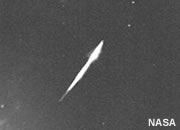
Meteoroid
A particle of iron or rock found in interplanetary space. Distinguished from planets or asteroids by its much smaller size.

Methane Hydrate
Methane hydrate is a crystalline solid that consists of a methane molecule surrounded by a cage of interlocking water molecules (see image at left). Methane hydrate is an "ice" that forms in sediments on the continental slope at a depth where cold temperatures occur. It has the potential to be tapped as a source of methane. There is more fuel value contained within Earth's methane hydrate than in all of the remaining oil and natural gas deposits combined.

Mica
Mica is the name used for a group of sheet silicate minerals with a generalized chemical composition of (K,Na,Ca)(Mg,Fe,Li,Al)2-3(OH,F)2[(Si,Al)4O10]. These minerals have basal cleavage which is so well developed that specimens have the ability to split into very thin sheets. Shown in the photo are the two most common mica minerals, biotite and muscovite.

Microseism
A vibration of the Earth that is unrelated to earthquake activity - instead it is caused by wind, moving trees, ocean waves, or human activity.

Milling
The activities of preparing an ore for market. These activities can include crushing, grinding, concentration, separation of impurities, and conversion into a transportable state. The image shows a ball mill, a large revolving drum into which ore is placed with large steel balls. The drum is rotated and the balls are tossed around inside, repeatedly impacting the ore and crushing it into a fine powder over time. This small particle size allows impurities to be separated from the target material.

Milling Capacity
The maximum amount of material that a mill can process in a unit of time. Tons per hour is a typical unit for milling capacity.

Mineral
A naturally occurring, inorganic solid with a definite chemical composition and an ordered internal structure. If it isn't grown, it is probably a mineral that is produced from a mine.
|
Dictionary of Geological Terms - Only $19.99 All scientific disciplines have an essential vocabulary that students and professionals must understand to learn and communicate effectively. A geology dictionary that is used regularly is one of the most important tools for developing professional competence. A good dictionary should be on the desk of every geologist and within easy reach. This dictionary is compact and inexpensive at only $19.99. More information. |

Mineral Interest
An ownership, lease, concession, or other contractual interest that gives a party the right to explore and extract mineral resources on a property. The photo shows test drilling of a mineral property.

Mineral Lease
A contract in which a mineral interest owner conveys to another party a right to explore for, develop, and produce mineral resources. The lessee acquires a working interest and the lessor retains a royalty interest of a specified percentage. The photo shows test drilling of a mineral property.

Mineralogy
The study of minerals - their composition, structure, formation, uses, properties, occurrence, and geographic distribution.

Mineraloid
A mineraloid is an amorphous, naturally occurring inorganic solid that does not exhibit crystallinity. It may have the outward appearance of a mineral, but it does not have the “ordered atomic structure” required to meet the definition of a mineral. The photo shows a piece of obsidian, which is a mineraloid because as a glass it does not possess a crystalline structure. Other well-known mineraloids are pumice, opal, and limonite.

Mineral Pigments
Pigments that are made by crushing minerals to a fine powder. Most of the pigments that have been used across history have been made from minerals. People have been collecting minerals and using them as pigments for about 40,000 years. Hematite is used to produce a wide range of red to reddish-brown pigments. Limonite (a mineraloid) has been used to produce yellow to brown pigments as shown in the photo. Glauconite is used to create green, lazurite for blue, psilomelane for black, cinnabar for red, orpiment for orange, malachite for green, and barite for white. These are just a few examples of minerals used as pigments. The pigment minerals can be mixed with oil, water, and other liquids for use as a paint. They can also be used to give color to plaster, stucco, cosmetics, chalk, and similar material.

Mineral Rights
The ownership of rocks, minerals, and fluids beneath an area of land. The owner has the freedom to sell, lease, gift, or bequest these rights individually or entirely to others.

Mohorovicic Discontinuity
The boundary between the crust and the mantle. Frequently referred to as the Moho. In the image, the Moho is the thin red line at the base of the crust.

Mohs Hardness Scale
A collection of minerals ranging from very soft to very hard. Use as a comparison scale during mineral identification. From softest to hardest, the ten minerals are: talc 1, gypsum 2, calcite 3, fluorite 4, apatite 5, orthoclase 6, quartz 7, topaz 8, corundum 9, and diamond 10. Developed by Friedrich Mohs, a German mineralogist, in the early 1800s.


Molecule
A group of two or more atoms held together by chemical bonds. The group of atoms does not have an electrical charge and is the smallest possible unit of that substance that is possible. The image shows a sodium atom and a chlorine atom combined to produce a salt molecule.

Monocline
An area of increased dip in otherwise gently dipping strata. The image shows a monocline over a reverse fault.

Mookaite
A colorful gem material mined in Australia. It forms from the deposition and lithification of a sediment composed of the silica tests of radiolarians. The resulting rock is known as a radiolarite. It is a popular gem material for making cabochons and beads.

Moonstone
Moonstone is a name given to translucent orthoclase feldspar that exhibits adularescence (a white-to-bluish light that floats just under the surface of the stone when it is turned under a source of light). It is a very popular gemstone.

Moraine
A mound, ridge, or ground covering of unstratified and unsorted till, deposited by ice action or by melting away of a glacier. Many different types of moraines are distinguished: terminal, ground, lateral, ablation, medial, push, and recessional. The photo shows a push moraine formed by the Harriman Glacier of Alaska.


Moss Agate
Moss agate is a transparent-to-translucent chalcedony that contains mineral inclusions which are shaped like moss, trees, leaves, or other vegetation.

Mother of Pearl
Mother of pearl, also known as "MOP," is the thin inner nacreous layer of a mollusk shell. It can be white, cream, or gray in color with a beautiful iridescent play-of-color. It is cut and shaped for use in jewelry, buttons, musical instruments, and more.

Mountain
A general term used in reference to an area that is at a conspicuously higher elevation than surrounding lands. Mountains are larger than hills and are significant enough in relief that they are given names by local residents. Shown in the photo is Mount Everest, the mountain with the highest altitude (8,850 meters / 29,035 feet).
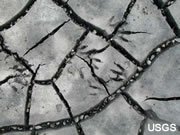
Mud Cracks
A network of polygonal shrinkage cracks that open in mud as the water within is slowly evaporated. They can harden, and if buried, can be lithified as a preserved sediment surface that is evidence of submersion followed by subaerial exposure. They can indicate a sedimentary environment of a lake shore, river bank, or low-energy beach. Also known as desiccation cracks.

Mudflow
A downslope movement of wet soil and rock debris that is mostly composed of clay-size particles and water. At the base of the slope, the flow spreads out over the runout area in the form of a lobe. The internal particle motion is that of a flow rather than of a rotating or translating mass. Many mudflows move at a rate of a few feet per year or less, but some reach speeds in excess of 60 miles per hour. Movement is usually triggered during times of heavy rainfall or rapid snow melt.

Mud Logger
A worker at a drilling site who does the work of "mud logging."
Mud Logging
During the drilling of a well for oil, natural gas, water, gold, coal, iron ore, or almost any resource, a record of the rocks penetrated by the drill is often desired. This information is valuable for knowing the type of overburden that must be mined through, the roof rock quality of an underground mine, correlation of rock units between wells or outcrops, sampling of the target rock unit, and many other purposes.
Samples of drill cuttings are collected from the drilling mud and labeled with depth and other information as the well is being drilled. The cuttings are then cleaned and dried, then examined by geologists known as "mud loggers" who prepare written and photographic records of the rocks penetrated by the well. The cuttings are often archived for future reference.
Shown in the photo are samples of wet mud collected from the well before cleaning and drying. For this project, samples were collected every ten feet and placed in a sample tray. This photo shows a small portion of that tray.

Mudstone
A sedimentary rock composed of clay-size particles but lacking the stratified structure that is characteristic of a shale. The image shows a hole in mudstone on Mars that was drilled by NASA's Curiosity Rover in May 2013. The hole is about 0.6 inch across.

Mud Volcano
A mud volcano is a vent in Earth's surface from which liquid mud erupts. They occur in at least three geologic situations: 1) in volcanic areas where hydrothermal activity produces steam and gas pressure that mobilizes mud and forces it to the surface; 2) where tectonic activity forces fluidized sediments to the surface; and, 3) where fluidized sediments pressurized by hydrocarbons are driven to the surface.

Multiple Completion Well
A well equipped to produce oil and/or gas from more than one subsurface rock unit. This is done by isolating the producing zones within the well with plugs. The production casing will be perforated between the plugs. These perforations will allow fluids that flow from the formation into the well bore to enter the production casing and be evacuated to the surface.

M.Y.
Million years - abbreviation.

M.Y.A.
Million years ago - abbreviation.

Mylonite
A fine-grained foliated metamorphic rock found in zones of ductile deformation as might occur near the shear zone of a fault.
|
| More General Geology |
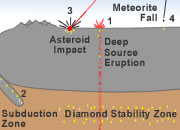 |
Diamonds from Coal? |
 |
What is a Geyser? |
 |
What is the San Andreas Fault? |
 |
Igneous and Volcanic Features |
 |
The Doorway to Hell |
 |
Topo Maps |
 |
Geology Dictionary |
 |
Gifts That Rock |

Find Other Topics on Geology.com:

|

| ||

|

| ||

|

| ||

|

|


